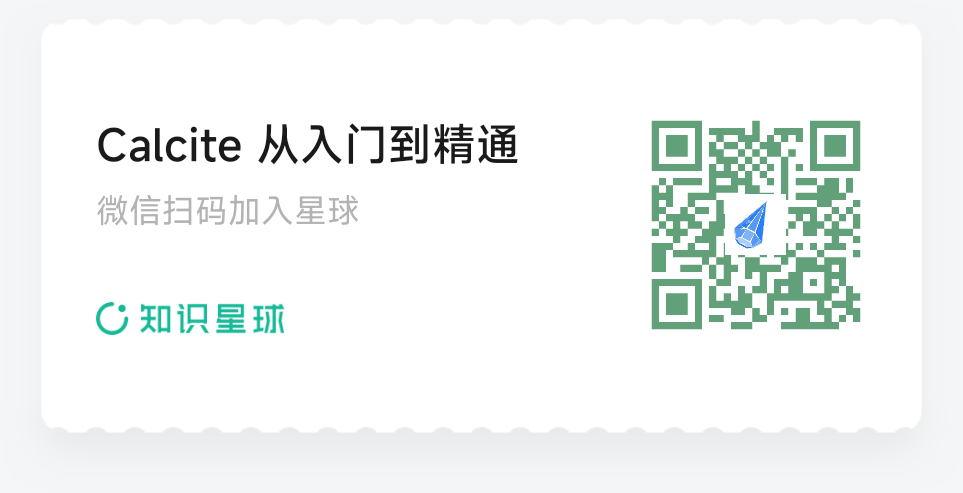Calcite 模型可以表示为 JSON/YAML 文件。本文描述了这些文件的结构。还可以使用 Schema SPI 编程的方式构建模型。
根节点
JSON:
1 | { |
YAML:
1 | version: 1.0 |
version:必填字符串,必须设置 version 属性值1.0;defaultSchema:可选字符串,如果指定,它将作为此模型中定义的模式名称(区分大小写),并将成为使用此模型 Calcite 连接的默认模式;schemas:模式元素的可选列表;types:所有模式共享的类型元素可选列表。
模式
配置在 root.schemas 节点中。
JSON:
1 | { |
YAML:
1 | name: foodmart |
name:必填字符串,模式的名称;type:可选字符串,默认为map,表示子类型。可选值为:path:可选列表,用于解析此模式中使用函数的 SQL 路径。如果指定,它必须是一个列表,并且列表的每个元素必须是字符串或字符串列表。例如,
JSON:
1 | path: [ ['usr', 'lib'], 'lib' ] |
YAML:
1 | path: |
声明一个包含两个元素的路径:模式 /usr/lib 和模式 /lib。大多数模式都位于顶层,对于这些模式,你可以使用字符串。
materializations (可选的物化视图列表)定义此模式中作为查询物化视图的表。
cache (可选布尔值,默认 true)告诉 Calcite 是否缓存此模式生成的元数据(包括表、函数和子模式)。
- 如果设置为
false,Calcite 将在每次需要元数据时访问模式,例如,每次需要表列表以验证某个模式中的查询时; - 如果设置为
true,Calcite 将在第一次读取元数据时缓存元数据。这可以带来更好的性能,特别是在名称匹配不区分大小写的情况下。
然而,这也导致了缓存陈旧的问题。特定模式实现可以重写 Schema.contentsHaveChangedSince 方法,来告诉 Calcite 何时应考虑缓存过期。
在模式中显式创建的表、函数、类型和子模式不受此缓存机制的影响。它们总是立即出现在模式中,并且永远不会被刷新。
Map 模式
与基类 Schema 一样,Map 模式同样出现在 root.schemas 中。
JSON:
1 | { |
YAML:
1 | name: foodmart |
name 、 type 、 path 、 cache 和 materializations 都继承自 Schema。
自定义模式
与基类 Schema 一样,自定义模式出现在 root.schemas 中。
JSON:
1 | { |
YAML:
1 | name: mongo |
name 、 type 、 path 、 cache 和 materializations 都继承自 Schema。
factory(必填字符串)是该模式的工厂类的名称。必须实现接口 org.apache.calcite.schema.SchemaFactory 并具有公共默认构造函数;operand(可选映射)包含要传递给工厂的属性。
JDBC 模式
与基类 Schema 一样,JDBC 模式出现在 root.schemas 中。
JSON:
1 | { |
YAML:
1 | name: foodmart |
name 、 type 、 path 、 cache 和 materializations 继承自 Schema。
jdbcDriver(可选字符串)是 JDBC 驱动程序类的名称。如果未指定,则使用 JDBC DriverManager 选择的任何类;jdbcUrl(可选字符串)是 JDBC 连接字符串,例如:jdbc:mysql://localhost/foodmart;jdbcUser(可选字符串)是 JDBC 用户名;jdbcPassword(可选字符串)是 JDBC 密码;jdbcCatalog(可选字符串)是 JDBC 数据源中初始目录的名称;jdbcSchema(可选字符串)是 JDBC 数据源中初始模式的名称。
物化视图
出现在 root.schemas.materializations 中。
JSON:
1 | { |
YAML:
1 | view: V |
view(可选字符串)是视图的名称。null表示该表已经存在,并且填充了正确的数据;table(必填字符串)是在查询中物化数据表的名称。如果view不为空,则该表可能不存在,如果不存在,Calcite 将创建并填充内存中的表;sql(可选字符串,或者可选的多行连接字符串列表)是具体化的 SQL 定义。
表
出现在 root.schemas.tables 中。
JSON:
1 | { |
YAML:
1 | name: sales_fact |
name(必填字符串)是该表的名称。在模式中必须是唯一的;type(可选字符串,默认为custom)表示子类型。值为:columns(Column 元素列表,对于某些类型的表是必需的,对于其他类型的表是可选的,例如 View)。
视图
与基类 Table 一样,出现在 root.schemas.tables 中。
JSON:
1 | { |
YAML:
1 | name: female_emps |
name 、 type 、 columns 都继承自 Table。
sql(必填字符串,或者必填的多行字符串的字符串列表)是视图的 SQL 定义;path(可选列表)代表解析查询的 SQL 路径。如果未指定,则默认为当前模式;modifiable(可选布尔值)代表视图是否可修改。如果为null或未指定,Calcite 会推断视图是否可修改。
如果视图仅包含 SELECT、FROM、WHERE(无 JOIN、聚合或子查询)并且每列满足以下条件,则视图是可修改的:
- 在 SELECT 子句中指定一次;
- 出现在带有
column = literal谓词的 WHERE 子句中; - 可以为空。
第二个子句允许 Calcite 自动为隐藏列提供正确的值。它在多租户环境中很有用,其中 tenantId 列是隐藏的、强制的(NOT NULL),并且对于特定视图具有常量值。
有关可修改视图的错误:
- 如果视图标记为
modifiable: true并且不可修改,Calcite 在读取模式时会抛出错误; - 如果你向不可修改的视图提交 INSERT、UPDATE 或 UPSERT 命令,Calcite 在验证语句时会抛出错误;
- 如果 DML 语句创建的行不会出现在视图中(例如,上面
female_emps中的行,带有gender = 'M'),Calcite 在执行该语句时会抛出错误。
自定义表
与基类 Table 类似,出现在 root.schemas.tables 中。
JSON:
1 | { |
YAML:
1 | name: female_emps |
name 、 type 、 columns 继承自 Table。
factory(必填字符串)是该表的工厂类的名称。必须实现接口 org.apache.calcite.schema.TableFactory 并具有公共默认构造函数;operand(可选映射)包含要传递给工厂的属性。
流式查询
有关表是否允许流式传输的信息。出现在 root.schemas.tables.stream。
JSON:
1 | { |
YAML:
1 | stream: true |
stream(可选;默认 true)表示表是否允许流式传输;history(可选;默认 false)表示流的历史记录是否可用。
列
出现在 root.schemas.tables.columns 中。
JSON:
1 | { |
YAML:
1 | name: empno |
name(必填字符串)代表该列的名称。
函数
出现在 root.schemas.functions 中。
JSON:
1 | { |
YAML:
1 | name: MY_PLUS |
name(必填字符串)表示该函数的名称;className(必填字符串)表示实现此函数类的名称;methodName(可选字符串)表示实现此功能方法的名称。
如果指定了 methodName ,则该方法必须存在(区分大小写),并且 Calcite 将创建一个标量函数。该方法可以是静态或非静态的,但如果是非静态的,则该类必须具有不带参数的公共构造函数。
如果 methodName 是 *,Calcite 会为类中的每个方法创建一个函数。
如果未指定 methodName ,Calcite 会查找名为 eval 的方法,如果找到,则创建表宏或标量函数。它还查找方法 init、add、merge、result,如果找到,则创建一个聚合函数。
path(可选字符串列表)是解析此函数的路径。
类型
出现在 root.types 和 root.schemas.types 中。
JSON:
1 | { |
YAML:
1 | name: mytype1 |
name(必填字符串)表示该类型的名称;type(可选)表示 SQL 类型;attributes(可选)表示该类型的属性列表。如果attributes和type两者存在于同一级别,type则优先。
Lattice 格
出现在 root.schemas.lattices 中。
JSON:
1 | { |
YAML:
1 | name: star |
name(必填字符串)表示该格的名称;sql(必填字符串,或者必填的多行字符串的字符串列表)表示定义该格的事实表、维度表和连接路径的 SQL 语句;auto(可选布尔值,默认 true)表示执行查询时,是否根据需要物化块;algorithm(可选布尔值,默认 false)表示是否使用优化算法,来建议和填充初始块集;algorithmMaxMillis(可选长整型,默认为-1,表示无限制)表示运行算法的最大毫秒数。在此之后,获取算法迄今为止得出的最佳结果;rowCountEstimate(可选 double,默认 1000.0)表示网格中的估计行数;tiles(Tile 元素的可选列表)表示要预先创建的物化聚合的列表;defaultMeasures(可选的度量元素列表)表示图块默认应具有的度量列表。tiles中定义的任何图块仍然可以定义自己的度量,包括不在此列表中的度量。如果未指定,默认的度量列表只是count(*):
JSON:
1 | [ { name: 'count' } ] |
YAML:
1 | name: count |
statisticProvider (实现 org.apache.calcite.materialize.LatticeStatisticProvider 的类的可选名称)提供每列中不同值数量的估计。
你可以使用类名,或类加静态字段。例子:
1 | "statisticProvider": "org.apache.calcite.materialize.Lattices#CACHING_SQL_STATISTIC_PROVIDER" |
如果未设置,Calcite 将生成并执行 SQL 查询以查找真实值,并缓存结果。
另请参见:Lattice 格。
Tile 块
出现在 root.schemas.lattices.tiles 中。
1 | { |
YAML:
1 | dimensions: [ 'the_year', ['t', 'quarter'] ] |
dimensions(字符串列表或字符串列表,必填,但可以为空)定义此 Tile 块的维度。每个维度都是 Lattice 格中的一列,就像一个GROUP BY子句。每个元素可以是字符串(Lattice 格内列的唯一标签)或字符串列表(由表别名和列名组成的对);measures(Measure 元素的可选列表)表示应用于参数的聚合函数列表。如果未指定,则使用 Lattice 格的默认度量列表。
度量
出现在 root.schemas.lattices.defaultMeasures 和 root.schemas.lattices.tiles.measures 中。
JSON:
1 | { |
YAML:
1 | agg: sum |
agg是聚合函数的名称(通常为count、sum、min、max);args(可选)是列标签(字符串),或零个或多个列标签的列表。
有效值为:
- 未指定:无参数;
- null:没有参数;
- 空列表:无参数;
- String:单个参数,格子列的名称;
- 列表:多个参数,每个参数一个列标签。
与点阵维度不同,度量不能以限定格式 {@code [“table”, “column”]} 指定。定义晶格时,请确保要用作度量的每一列在晶格内都有唯一的标签(如有必要,请使用 “{@code AS label}”),并在想要传递该列时使用该标签作为衡量参数。
写在最后
笔者因为工作原因接触到 Calcite,前期学习过程中,深感 Calcite 学习资料之匮乏,因此创建了 Calcite 从入门到精通知识星球,希望能够将学习过程中的资料和经验沉淀下来,为更多想要学习 Calcite 的朋友提供一些帮助。

